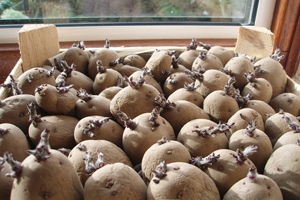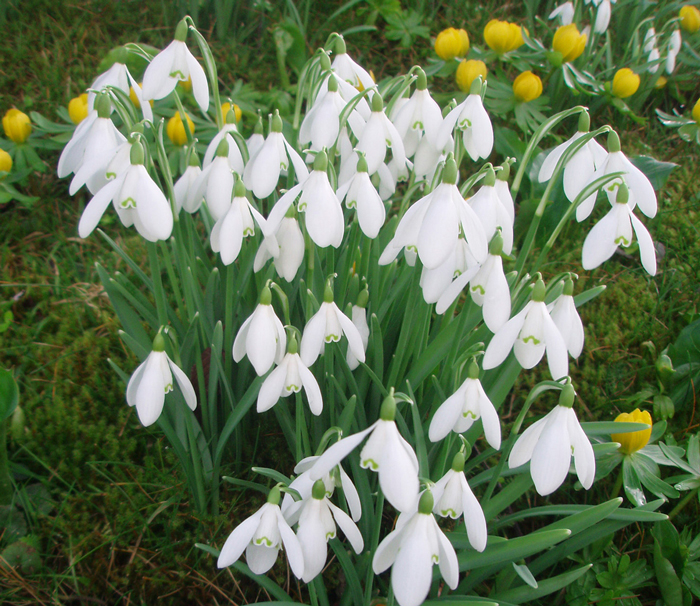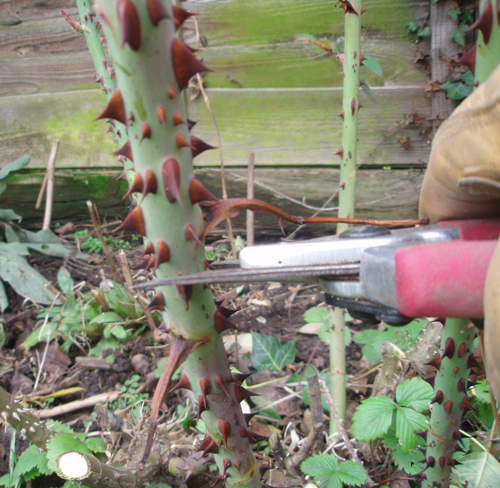February Garden Diary
Our February gardening diary is brought to you by Geoff Hodge of The Scotts Miracle-Gro Company – Lovethegarden.com
February is usually the coldest month of the year. This may prevent you spending much time in the garden – but make the most of any mild days and get on with whatever you can. The weather can be very variable, with warm days followed by severe frosts and cold winds, which can severely affect young growth and new plants. Horticultural fleece will help give some protection against both cold and frost.
FLOWER BEDS & BORDERS
If your snowdrops have been growing in the same soil for several years and haven’t flowered well this year, then it’s a good idea to do something about it. Carefully lift the bulbs – this can be done when they’re still in leaf, or ‘in the green’ – without damaging the roots too much. Split the clumps into smaller sections and replant at the same depth in soil that has been improved with lots of organic matter, such as home-made compost, well-rotted manure or planting compost. Then water them in well, adding a liquid feed to the water.
Dry snowdrop bulbs planted in autumn often fail to grow or don’t perform well because they have dried out too much. Growing snowdrops from plants and planting when flowering has finished, but they’re still in leaf, is usually a better bet – or, better still, buy potted plants. Plants sold in the green are often freshly dug up, so it is vital to water them in well as soon as they are planted.
Deadhead winter-flowering pansies and other winter- and spring-flowering bedding plants regularly to keep them flowering well. Give them a liquid feed to help improve flowering.
Sow sweet pea seeds singly in sweet pea tubes or Rootrainers, which allow maximum root development, filled with a good seed sowing compost. Place them in a cold frame, cold greenhouse or conservatory to germinate.
Topical tip
Tidy up herbaceous perennials, removing any dead or damaged leaves plus any dead flower stems that were left on over winter.
PATIO GARDENING
Trees, shrubs, fruit and other long-term plants growing in containers will benefit from topdressing with fresh compost. Scrape away the top 2.5-4cm (1-11/2in) of old compost and replace it with fresh. Loam-based John Innes Compost No 3 or a multi-purpose compost with added John Innes are the best choices for these plants. Mix in some controlled-release plant food into the fresh compost, which will feed the plants throughout spring and summer from just one application.
Plants that have been in their containers for several years may have become potbound, which could affect their performance and also mean they need very careful, regular watering throughout spring and summer. If they are already in large pots and you can’t move them into even larger ones, it pays to freshen them up. Carefully remove them from the container and work over the outside of the rootball with a hand fork to remove old and dead roots and old, stale compost. Then put them back in the same pot with fresh John Innes Compost No 3 and a controlled-release plant food.
Plants may start growing during warmer spells, or even continue growing after the mild winter, so check the compost to make sure it remains moist and doesn’t dry out.
Topical tip
For a great summer display of colour and scent, plant lily bulbs in pots for a fantastic patio feature.
LAWNS
This is a great time to create a new lawn, or repair a damaged one, by laying turf, providing the soil isn’t frozen or waterlogged. To ensure you achieve a luscious green lawn to be proud of, it pays to do some soil preparation work first.
Start by digging over the soil to a depth of 15-23cm (6-9in) and improve it with compost, lawn soil, soil conditioner or similar material and, at the same time, remove large stones, the roots of perennial weeds and other debris. If your soil is very heavy clay, it may even pay dividends to add some sharp sand to the soil too.
Rake the area flat and level, and then lightly consolidate the soil by walking over the area with your weight on your heels and rake flat and level again. You’re now ready to start laying the turf. Lay your first row of turfs along a straight edge. Butt each one closely to the last and ensure good contact with the soil by tamping down firmly with the back of a rake. Lay the next row, again ensuring each turf is pushed right up to its neighbour. Stagger each row in a brickwork pattern. Finally, water the turf well or, better still, water and feed with a liquid plant food to aid rapid establishment.
You can also do this soil preparation if you plan to sow grass seed, but wait until next month to actually do the sowing. This early work is a good idea, as it gives time for weed seeds in the soil to germinate and you can then hoe them off or spray with a non-selective weedkiller that has no residual activity prior to sowing the seed. This helps reduce weed problems later on.
Topical Tip
In mild weather, at temperatures of 5C (41F) or above, the grass will grow and need mowing. But avoid walking on the lawn if the grass is frozen or wet.
GROW YOUR OWN
Vegetables
To make sure you grow all the veg you need this year, draw up your cropping plans and order or buy your seeds.
When you get your veg seeds, make a month-by-month seed sowing organiser in a cardboard box or similar. This way you won’t forget to sow everything at the right time. Store the seeds in cool, dry conditions until you’re ready to sow.
At this time of year there is an almost irresistible urge to start sowing seeds outside. But, unless your soil is very well drained and you live in a sheltered mild district, it is far better to wait until spring. Most vegetable seeds that are sown outdoors won’t germinate until the soil temperature reaches 7C (45F) and if sown in cold soil will rot.
But you can get ready for an early start by covering beds with cloches or sheets of clear polythene. This warms the soil, keeps clay soils from getting too soggy during wet weather and encourages weeds to germinate. These weeds can then be dealt with before sowing to produce a ‘weed-free’ veg bed.
 Make sure you buy your seed potatoes as soon as possible, as the most popular varieties soon sell out. You can then start chitting early seed potatoes, which generally produces a bigger, better crop as a result. You can also chit maincrop varieties too.
Make sure you buy your seed potatoes as soon as possible, as the most popular varieties soon sell out. You can then start chitting early seed potatoes, which generally produces a bigger, better crop as a result. You can also chit maincrop varieties too.
Chitting means getting them into growth to produce strong young shoots before planting out. Stand the seed potatoes upright in trays or egg boxes with the ‘eye’ end (the end with the most eyes or buds) uppermost. Keep them somewhere cool but frost free, and in good light. The aim is to produce strong, sturdy, green shoots. If the shoots are long and white, then the conditions are either too warm, too dark or both.
Topical tip
Check overwintering crops – such as brassicas, leeks and onions – and clear away any damaged, diseased or dead leaves to prevent build up of possible problems.
Fruit
This is a great time to plant fruit trees and bushes, providing the soil isn’t waterlogged or frozen solid. Planting bare-rooted fruit needs to be completed by the end of the month. When planting, dig over the planting area and make sure the soil is well prepared with plenty of added organic matter – such as well-rotted manure, garden compost or a tree and shrub planting compost. Water the roots thoroughly before planting. Plant at the same depth that the plant was originally growing and carefully firm the soil around the roots. Apply a general granular plant food or, even better, a controlled-release feed.
Trees will need to be staked with a good tree stake and secured with two tree ties. Water in well and keep well watered during establishment and during dry periods for the first year. After planting, apply a 5-7.5cm (2-3in) thick mulch of organic matter over the soil around the plant. This will help maintain soil moisture levels during summer and prevent weeds growing.
Towards the middle or end of the month, give all fruit a good start to the year by applying a granular balanced plant food. This should be applied over the main rooting area – roughly equivalent to the spread of the branches. A high potassium feed can be beneficial in addition to the balanced feed, especially for heavy-cropping fruit and those that didn’t crop too well last year. Mulch all fruit after feeding using the mulching materials mentioned above.
Prune autumn-fruiting raspberries by cutting down all the canes to the ground. Summer raspberries can be cut back to one or two buds above the top of their supporting wires if they’ve grown too tall.
Topical tip
Protect the blossom of early-flowering apricots, peaches and nectarines from frost damage by covering plants with fleece. But remove it on warm days, especially when pollinating insects are about.
TREES, SHRUBS, ROSES & CLIMBERS
There are lots of shrubs and woody climbers that need pruning this month to improve flowering. After pruning, give the plants a feed with a good quality rose food to help them recover and produce good, flowering growth for colourful future displays.
Winter-flowering shrubs can be pruned immediately after flowering, removing the flowering growth and thinning out up to one-third of the oldest stems. To prune winter jasmine (Jasminum nudiflorum), remove any dead or damaged shoots, tie in new shoots to the main framework, and then shorten all the laterals/sideshoots from the main framework to 5cm (2in). Winter-flowering heathers should be trimmed back as soon as they finish flowering. Cut back the flowered stems plus about 2.5cm (1in) of the leafy growth below them with shears.
Prune bush and climbing roses towards the end of the month – or you can leave it until early March if the weather is particularly cold. As a general rule: the harder you prune them, the better the regrowth and flowering display. Start by cutting out any thin, dead, diseased, damaged, rubbing or crossing stems and then prune back the remainder. Hybrid teas: shorten strong shoots to 10-15cm (4-6in) long; weaker shoots to two to three buds. Floribundas: shorten strong shoots to 23-30cm (9-12in); prune less vigorous shoots more severely. Climbers: Cut back main branches by about one-third and shorten sideshoots to two to three buds. After pruning feed all roses with a granular rose food or a controlled-release rose food.
Topical tip
This is a great time to plant all manner of hardy trees, shrubs, roses and climbers. See FRUIT for details.
GENERAL GARDENING JOBS
Many diseases overwinter in the soil, or on plant debris, so always clear away any plant debris and old leaves. These can also be overwintering places for insect and other pests – especially slugs and snails. Garden hygiene helps greatly in the prevention of disease carry-over from one year to the next. Always rake up and destroy any badly infected leaves; burn or bin them. Many diseases, such as black spot on roses, scab on apples and pears and rusts, can all be controlled to some extent in this way.
Garden birds will still rely on us to put out food for them; they are particularly in need during cold and freezing weather. At this time they need food with a high energy and fat content. Top up bird feeders as necessary. Bird tables should only be stocked with enough food that the birds can eat without leaving excess from day to day. And don’t forget to ensure there is a supply of unfrozen, clean water.
Topical tip
If home-made compost is ready to use, spread it over the soil – either as a soil improver or as a mulching material. If it’s not ready, empty it out from the compost bin or heap, mix it up well and refill the bin or make a new heap.
HOUSEPLANTS
Achimenes, begonia and gloxinia tubers can be planted this month. Begonias and gloxinias need to be planted with their hollow side facing upwards. Plant six achimenes tubercles in a 15cm (6in) pot of just moist compost at a temperature of 15-18C (60-65F). Press begonia tubers into trays of compost at a temperature of 15-18C (60-65F) and then transplant individually into small pots once the shoots have started to produce leaves.
Take particular care of poinsettias, cyclamen, azaleas and other winter-flowering houseplants to keep their displays going for as long as possible. Water carefully with tepid water and feed fortnightly with a suitable liquid plant food.
Topical tip
Cut back leggy coleus, hypoestes (polka dot plant), pilea (aluminium plant) and tradescantia plants to encourage new, bushy growth and a better shape.
Use plant protection products & biocides safely. Always read the label and product information before use. Pay attention to the risk indications and follow the safety precautions on the label.
For further gardening advice, news and information on all Scotts Miracle-Gro products, visit www.lovethegarden.com



